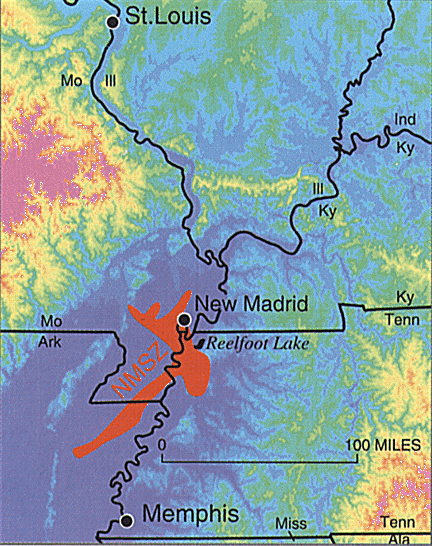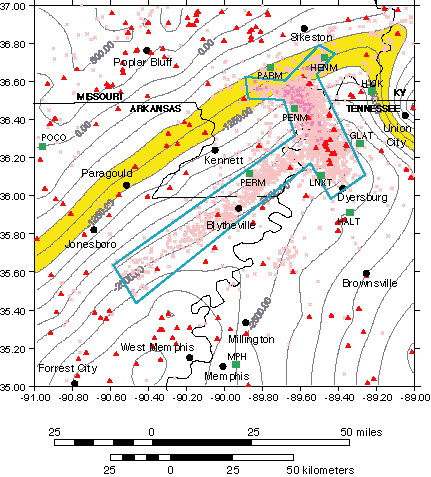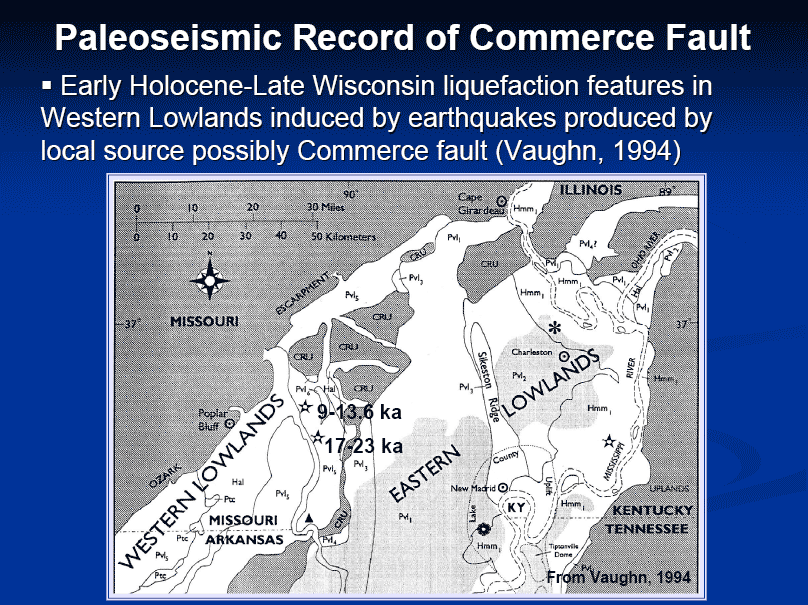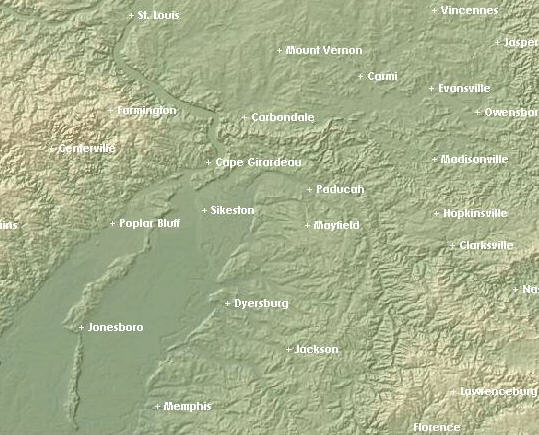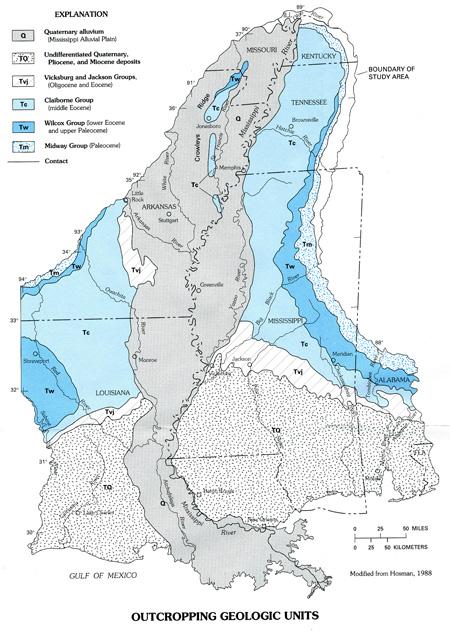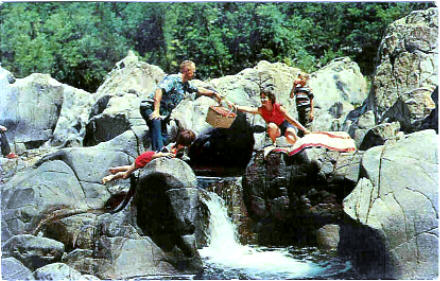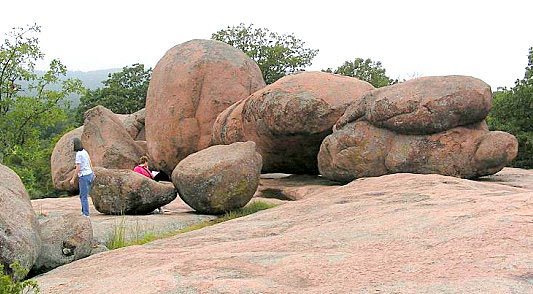Main page
Site map
Fault maps
Aerial views
Recent quake
Haiti: Lesson
Rivers moved
Origins
Ancestral rivers
Ran backward
Preparing
Eyewitnesses
Civil War NM
1811 scenario
Mag 7.7
Self tour
Catastrophic
Iben Browning
1895 quake
1968 quake
Dinosaur fault
M7.0 not high 7
Okla fault
How likely?
Gas lines
Porters Gap
NMSZ news
San Andreas pic
Sikeston shakes
Russian Roulette
Preparing
Preparing family
Before, during,
Wabash Valley
Feldman book
Find a sandboil
Seismic FAQs
Report a quake
What is NMSZ?
Tectonic?
Hidden Fury video
New Memphis Fault
Impact
How much bigger?
N Madrid 1789
Global cooling?
newmadridfault.info redirects here

Drop, cover,
hold on
ANCIENT VOLCANO COMPLEX IN THE UNTIED STATES
WE ARE WAY MORE CONNECTED UNDER THE GROUND THAN WE REALIZE!
| 1-16-11 DREAM: i was living in southern Wisconsin, and
my mother-in-law came to visit our family. She drew us a
map of the Eastern half of the United States and drew lines on
it that included all the ancient magma tunnels under the surface
that were going to soon let lava flow from an ancient volcano
that was soon to come to life in North//South Carolina, and work
its way all the way up through all the states up to Wisconsin.
The map she drew us went all the up to the Wisconsin River area west of Madison, WI. She said that it was due to come to life and it was dangerous to stay anywhere in the vacinity of theh entire map but the worst would be in Wisconsin where the magma would finally come out of the ground. She told us that we would have to go all the way up into Canada to be safe. My husband had a couple days of work left on the job he was doing, and she said we would have that time left, but no more and we'd have to take our children immediately then and leave the state into Canada. That's all the warning we would get because when the ancient volcano came to life, there would be little warning. . |
Local Seashore
Dinosaurs, glaciers, earthquakes, volcanoes
|
|
..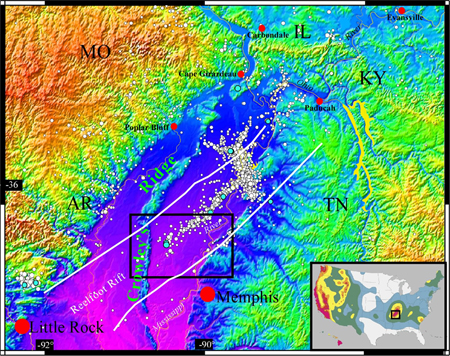 |
Old Ohio Riverbed, glacier
The yellow band of hills across Southern Illinois are the edge of glacier debris. You can see picturesque leftover boulders at Giant City State Park, near Carbondale, Fern Clyffe State Park near Marion, the long "Goreville hill" on I-57, and the beautiful Garden of the Gods near Harrisburg, where signs say it took the glacier a few hundred years to melt. Illinois glaciation
An old Ohio riverbed curved sharply westward, just south of present Golconda in SE Illinois (thin dark blue on top map, yellow on smaller map below, increasing in width westward) running a few miles south of the present Illinois Route 146. Most of the dark blue of Illinois in upper map is the present Cache River Basin and Natural Area.
news | news | nature.org | wikipedia

The old river bed continued near Olive Branch IL, Commerce MO, along ridges near Benton and Morley, MO, then south through flatland into Arkansas.
The darker blue (top map) of the old Mississippi River bed curves sharply west at the regional airport between present Scott City and Cape Girardeau.
Old Mississippi River paths; draining the swamp
The sharp westward turn of the Mississippi just south of Cape Girardeau handled the melting runoff of North America's ice ages. The Western Lowlands on the west side of Crowley's Ridge near Advance and Poplar Bluff handled the earlier Illinoian ice age melting, leaving us the Mingo Swamp and wildlife area. The later Wisconsin ice age runoff went mostly on the eastern side of the ridge. | Mingo | Crowley's
- Draining the larger swamp - in Southeast Missouri - in the early 20th century is a separate story.
- See numerous north-south ditches on the map. more In the southern bootheel, five drainage ditches run alongside each other as they drain into Big Lake, a large shallow swampy lake formed in 1811.
- For current efforts to curb river flooding between Cairo and East Prairie, search St. John's Bayou-New Madrid Floodway Project. Shaping the river today
- 1200 px 1892 map of Crowley's Ridge.
- A simpler map of SE Missouri before draining the swamp.
- 2007 Story of the Little River Drainage District (LRDD)
- 2004 Story of Little River Drainage District
- Map of Oran-Bell city gap (eastern lowlands), western lowlands, Thebes gap
The Eastern Lowlands beginning near the community
of Delta, include the "Bell City-Oran Gap" (both towns are on current
maps) on the east side of Crowley's Ridge. The layered rock
outcroppings on the low hills near Chaffee and Oran appear smooth and
pitted.
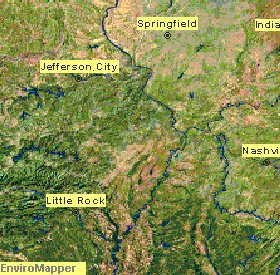 [ref.]
It doesn't take much imagination for an observer to see this was once a
wide, shallow river bottom.
[ref.]
It doesn't take much imagination for an observer to see this was once a
wide, shallow river bottom.
The Ohio River may have even joined the Mississippi at Morley, between Benton and Sikeston, for a time.
See the green strip on the map at left, southwest of the current confluence of the two rivers. This is the Crowley's Ridge separation between the eastern and western lowlands.
The glacier runoff deposited much sand and light dusty soil in these areas. The rivers eroded some of this sandy alluvium and formed a newer and lower flood plain in a portion of the valleys. The older and higher flood-plain surfaces that have been left are terraces.
The four glacial stages, Nebraskan, Kansan, Illinoian, and Wisconsinan, are named for their most southerly advances. The Wisconsinan stage covered much of the northern United States from the Atlantic coast to the Rocky Mountains as recently as 12,000 years ago.
The National Park Service says
| About 18,000 years ago a continental glacier covered North America. This continental glaciation event, with its gradual melting period from 12,000 to 7,500 years ago, was the last in a series of continental glaciers that have formed and then receded over the last 25 million years. As the glaciers melted and reformed, the Mississippi and its tributaries carved valleys and created floodplains across the region. --nps.gov |
Global warming??? Bosh and poppycock. It's only temporary.
Swamps and marine life covered much of Illinois, south of the Quad cities to Mt. Vernon (during the Pennsylvanian age).
Thebes gap - a latecomer
Some geologists believe the heavy seismic activity along the Commerce Lineament, about 10,000 years ago helped the Mississippi River cut through the "Thebes gap" (about 12 miles, between Thebes IL and Commerce MO) and make a new confluence at Cairo, IL. It then switched from a braided river to the meandering river through rock cuts that forms the state boundaries today. Here's an infrared view | another.
The Mississippi in older days migrated rapidly by eroding on the outside of a river bend and depositing point bars on the inside of the river bend. Abundant oxbow lakes mark old positions of the channel that have been abandoned.
Native Americans liked to settle along these oxbow lakes because the fishing, hunting and water supply was good, but the threat of flooding was less than along the river.
Researcher Margaret Guccione with the University of Arkansas finds the Mississippi's path changed significantly at the time of the AD 1450-1470 New Madrid earthquake.
The land at Reelfoot appears to have risen four meters in 1,000 years - quickly in geologic time. Only part of that can be accounted for in the 1811-12 quakes, she said. The rise, along with sinking of some land, blocked the flow of a creek to create Reelfoot Lake.
-
Geological Society of America Bulletin Volume: 112 Issue: 2 Pages: 221-235
-
Saucier, Roger T., 1994, Geomorphology and Quaternary Geologic History of the Lower Mississippi Valley. Mississippi River Valley Commission, U. S. Army Corps of Engineers, Vicksburg, Mississippi.
Mississippi Embayment
Sediment layers, Memphis aquafer, Reelfoot Rift
Writing in the January 2007 issue of Scientific American, Roy B. Van Arsdale and Randel Cox of the University of Memphis offered the following explanation of the embayment's complex origin.
As Pangaea began to break up about 95 million years ago, North America passed over a volcanic "hot spot" in the earth's mantle (specifically, the Bermuda hot spot) that was undergoing a period of intense activity. The upwelling of magma from the hot spot forced the further uplift to a height of perhaps 2-3 km of part of the Appalachian-Ouachita range, forming an arch. The uplifted land quickly eroded and, as North America moved away from the hot spot and as the hot spot's activity declined, the crust beneath the embayment region cooled, contracted and subsided to a depth of 2.6 km, forming a trough that was flooded by the Gulf of Mexico. As sea levels dropped, the Mississippi and other rivers extended their courses into the embayment, which gradually became filled with sediment. -- answers.com/topic/mississippi-embayment/
(Below) Contour lines show where a shallow Gulf of Mexico once covered the lower Mississippi Valley to Dexter, MO, and just above the junction of the Ohio and Mississippi Rivers at Cairo, IL. (See a great explanation.) Its sandy sediment deposits make the ground even shakier in earthquake territory. It was called the Mississippi Embayment Synclinorium.
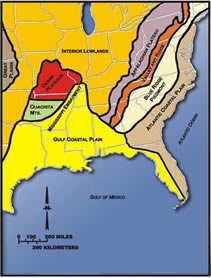 |
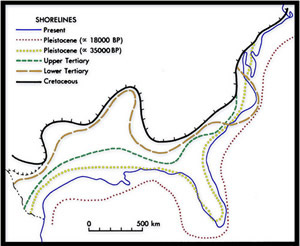 |
http://www.csc.noaa.gov/beachnourishment/html/geo/
Until approximately 20,000 years ago, when glaciers were at their maximum extent, sea level was some 125 meters below its current level, and nearly all of the present-day continental shelf was exposed.
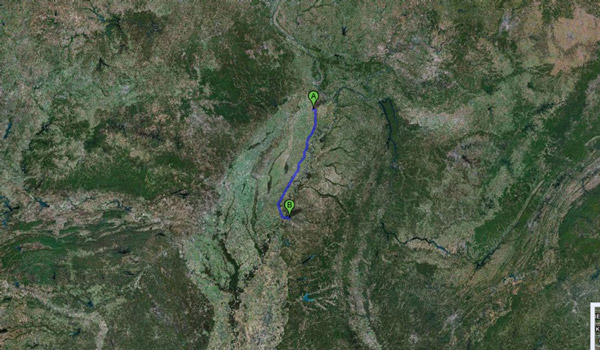
Above: Swirls in the mud? Sort of. Point A is Sikeston, MO. B is Memphis. Appalachians are at mid right. Dark streaks to the right of A are Kentucky and Barkley lakes, and Land Between the Lakes. See the "finger" shape of the Mississippi Embayment
Below: Texture of old barnwood? Point A is Knoxville, TN. Point B is Kingsport. White spots in lower right are clouds. The lines are the Appalachian Mountains, with some Smokies and Blue Ridge thrown in. They were formed when Africa pushed toward the Eastern US, way way back.
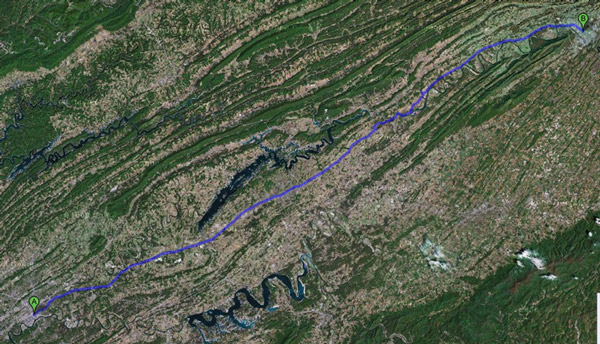
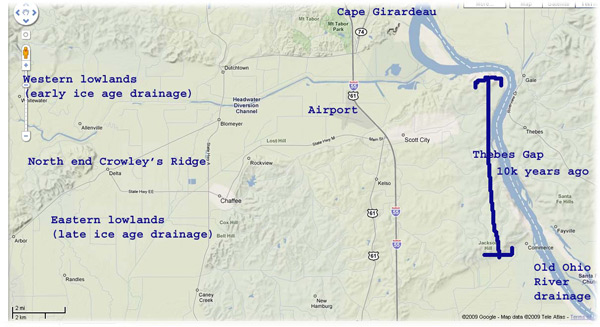
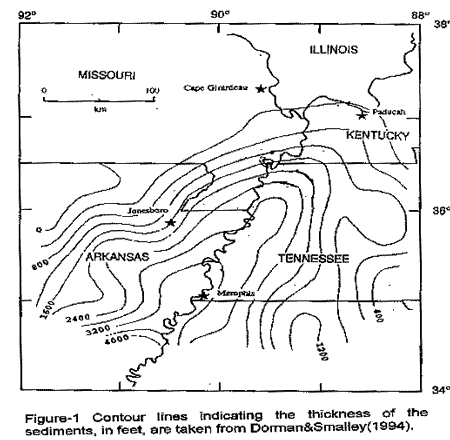
Click above for larger
Wikipedia map of embayment, Crowley's Ridge
The current sedimentary basin results from the filling of a Cretaceous tectonic basin and existed as a large bay in the Cretaceous through early Tertiary shoreline. --Wikipedia
USGS topography map of region near Cairo IL. See other satellite topography maps lower on this page.
Old paths, meanderings of Mississippi River over the centuries. (Makes nice artwork!) This comes from the Corps of Engineers... section from Cape Girardeau Mo, southward.
An artist who made pictures with sand and glue, told us he found 25 different colors of naturally occurring sand just in Stoddard County, (Dexter) MO at the north edge of the Bootheel. He believes the sand colors were formed when this landlocked area was a seashore.
A MO Department of Natural Resources person told us the underground water table in the Bootheel is sloped such that people in the southern Bootheel are now pumping water from their deep wells and community water systems that fell as rain, a million years ago, just north of the Bootheel.
Southeast Missouri Dinosaur
 The
town of Marble Hill, in Bollinger County, half an hour west of Cape
Girardeau, has
dinosaur remnants that were trapped in a seismic fault south of
town. Townspeople have opened a Natural History Museum. It's the only
dinosaur
found for many hundred miles. The duck-billed Hypsibema crassicauda
probably weighed two tons, was 10 feet tall,
ate plants, and lived 100 million years ago.
News story.
The
town of Marble Hill, in Bollinger County, half an hour west of Cape
Girardeau, has
dinosaur remnants that were trapped in a seismic fault south of
town. Townspeople have opened a Natural History Museum. It's the only
dinosaur
found for many hundred miles. The duck-billed Hypsibema crassicauda
probably weighed two tons, was 10 feet tall,
ate plants, and lived 100 million years ago.
News story.
Fossils of two and possibly three other types of dinosaurs were found at the site. One of these is a relative of Tyrannosaurus rex,
Read about the Cretaceous period | Southern Illinois dinosaurs?
Missouri's dinosaur was part of the Hadrosaur family.
 Model,
at Marble Hill museum
Model,
at Marble Hill museum
photo courtesy SE Missourian

Bollinger County Museum of Natural History
 207 Mayfield Drive Marble Hill, Missouri 63764
207 Mayfield Drive Marble Hill, Missouri 63764
573.238.1174 www.bcmnh.org
Note in map below - the grey streak across southern Illinois and southeast Missouri of Middle Cretaceous times, which are places where dinosaur bones might be found. Also note the yellow of the Great Plains, which at that time was a great ocean.

Volcanoes
One and a half billion years ago, hot volcanic ash and gases spewed into the air, then cooled, forming igneous rock. Later, shallow seas covered the rock, depositing sedimentary rock. The land rose. The sea fell.
It created Johnson's Shut-Ins, near Ironton, Farmington, southwest of St. Louis, ... and Elephant Rocks (lower picture), nearby.
|
|
KFVS 2007 look at
old volcano in SE MO's Mineral Area says it was probably
centered at Taum Sauk mountain.

Mastodons-Mammoths

USGS/Cascades Volcano Observatory, Vancouver, Washington
America's Volcanic Past
|
|||||||||||||||||||||||||||
| "Though few people in the United States may actually experience an erupting volcano, the evidence for earlier volcanism is preserved in many rocks of North America. Features seen in volcanic rocks only hours old are also present in ancient volcanic rocks, both at the surface and buried beneath younger deposits." -- Excerpt from: Brantley, 1994 |

Volcanic Highlights and Features:
| [NOTE: This list is just a sample of various Appalachian features or events and is by no means inclusive. All information presented here was gathered from other online websites and each excerpt is attributed back to the original source. Please use those sources in referencing any information on this webpage, and please visit those websites for more information on the Geology of the Appalachians.] |
- Appalachian Mountains
- Southern Appalachian Mountains - Brief Geologic History
- Appalachian National Scenic Trail
- Blue Ridge Mountains
- Blue Ridge National Parkway
- Great Smoky Mountains
- Great Smoky National Park
- Shenandoah National Park
- White Top Mountain, Virginia
The Appalachians are old. A look at rocks exposed in
today's Appalachian mountains reveals elongate belts of
folded and thrust faulted marine sedimentary rocks,
volcanic rocks and slivers of ancient ocean floor.
Strong evidence that these rocks were deformed during
plate collision. The birth of the Appalachian ranges,
some 480 million years ago, marks the first of several
mountain building plate collisions that culminated in
the construction of the supercontinent Pangea with the
Appalachians near the center. |
|||||
The Earth is approximately 4.5 billion years old. In the Southern Appalachians, the history of the last billion years is recorded in the rocks. By reading the rocks, we can trace their incredible history. BREAK UP OF A SUPERCONTINENT: The rocks at the core of the Appalachian Mountains formed more than a billion years ago. At that time,all of the continents were joined together in a single supercontinent surrounded by a single ocean. About 750 million years ago, the crust of the supercontinent began to thin and pull apart. As the crust expanded, a deep basin -- the Ocoee -- formed in what is now the western Carolinas, eastern Tennessee, and northern Georgia. Seawater filled the basin. Sediments formed by the weathering of surrounding hills were transported by water and deposited in layers on the floor of the basin. Over a long period of time, a great thickness of sediments accumulated. These sediments now form the bedrock of the Great Smoky Mountains. Within these sediments, minerals like pyrite and metals like copper were deposited. At the same time that the sediments were being laid down volcanoes were erupting in present-day Virginia, the Carolinas, and Georgia. Lava from some volcanoes flowed in slow moving sheets, but some eruptions were explosive. Then, about 540 million years ago, the supercontinent split into pieces that drifted away from each other. Seawater spread into low areas between crustal plates and,in time, formed new oceans. A shallow sea covered most of what is now the United States. CONTINENTAL COLLISION: About 470 million years ago, the motion of the
crustal plates changed, and the continents began to move
toward each other. Eventually, about 270 million years
ago, the continents ancestral to North America and
Africa collided. Huge masses of rock were pushed
west-ward along the margin of North America and piled up
to form the mountains that we know as the Appalachians.
As blocks of continental crust rode across one
another, some rocks became so hot that they melted. Some
of the molten rock remained deep below ground. There, it
cooled slowly and crystallized to form bodies of rock
that are called plutons. Granite is an example of an
plutonic rock. Some molten rock cooled very slowly and
formed coarse-grained veins called pegmatites.
Pegmatites have been the source of high-purity minerals
(such as feldspar,quartz,and mica) and gemstones (such
as emeralds and beryl). When continental masses collided with the edge of
ancestral North America, rocks were subjected to intense
pressure and heat. Where the temperature was high but
below the melting point of the rocks, the rocks deformed
and recrystallized to become metamorphic rocks. The
components separated into bands, and some flowed with a
consistency like that of toothpaste. During
metamorphism, temperatures and pressures can vary. In
less extreme conditions, original rock layers may be
partly retained. As a result, some minerals
recrystallized in sheets, forming rocks (slate or
schist) that split easily into thin, smooth layers.
The collision of continental plates is also expressed in the rocks by folds (bends)and faults (breaks). Earthquakes happen because of slippage along a fault. Although earthquakes are now rare in the Southern Appalachians, during the time of continental collision, earthquakes were a common occurrence. ANOTHER CONTINENTAL BREAK UP: Although a collision of continents caused the
formation of the Appalachian Mountains, the present-day
margin of North America is the result of a reversal in
crustal plate movement. After the continents collided,
the continental mass began to pull apart. About 240
million years ago, at the beginning of the age of the
dinosaurs, a new ocean basin began to form -- the
present-day Atlantic. The widening of the Atlantic Ocean
at the mid-Atlantic Ridge is evidence of this continuing
movement.
CARVING THE MOUNTAINS: At the time they formed, the Appalachians were much higher than they are today -- more like the present-day Rocky Mountains. While the Atlantic Ocean was still in its infancy, the Appalachians were already being attacked by erosion. For the last 100 million years, erosion has carved away the mountains, leaving only their cores standing. Erosion continues today and is constantly altering the landscape of the Southern Appalachians. Four times during the past 2 million to 3 million
years, great sheets of ice advanced steadily southward
from the polar region. The glaciers did not extend as
far south as the Southern Appalachians, but they
triggered a change in climate that can be seen today in
both the rocks and the life of the region. |
|||||
| Appalachian National Scenic Trail |
Appalachian National Scenic Trail:4
The Appalachian National Scenic Trail is a 2,167-mile (3,488
kilometers) footpath along the ridge crests and across the major
valleys of the Appalachian Mountains from Katahdin in Maine to
Springer Mountain in north Georgia. The trail traverses Maine,
New Hampshire, Vermont, Massachusetts, Connecticut, New York,
New Jersey, Pennsylvania, Maryland, West Virginia, Virginia,
Tennessee, North Carolina and Georgia.
| Blue Ridge Mountains - Blue Ridge National Parkway |
Blue Ridge Mountains:6
Most of the rocks that form the Blue Ridge are ancient granitic
and metamorphosed volcanic formations, some exceeding one
billion years in age. By comparison, humans have been associated
with this land only about 9,000 years.
Blue Ridge National Parkway:5,8
The Blue Ridge Parkway extends 469 miles along the crests of the
Southern Appalachians and links two eastern national parks:
Shenandoah and Great Smoky Mountains. In many places along the
Blue Ridge Parkway, there are metamorphic rocks (gneiss) with
folded bands of light-and dark-colored minerals, which sometimes
look like the folds and swirls in a marble cake.
| Great Smoky Mountains - Great Smoky Mountains National Park |
Great Smoky Mountains:2
Great Smoky Mountains National Park lies within the Appalachian
Blue Ridge geologic and physiographic province. The highest
mountains in eastern North America occur in the Blue Ridge
province, and some of the highest peaks in this province are in
the Great Smoky Mountains National Park. The oldest rocks in the
Blue Ridge province are at least 1 billion years old and consist
of metamorphosed sedimentary and igneous rocks. These
Proterozoic rocks form the core of the ancient Appalachian
Mountains. Sediments deposited over these older rocks form the
majority of rocks in the Great Smoky Mountains National Park.
Great Smoky Mountains National Park Rocks:2
Most of the rocks in Great Smoky Mountains National Park are
metamorphosed sedimentary rocks. These sedimentary rocks were
formed from approximately 800 to 450 million years ago from
deposits of clay, silt, sand, gravel, and lime or calcium
carbonate. The oldest sedimentary rocks consist of vast amounts
of clastic material that washed down into lowland basins from
adjacent highlands. Rocks of the ancient highlands are similar
to the ancient granite, gneiss, and schist found in the eastern
parts of the Great Smoky Mountains National Park. Approximately
450 million years ago, the rocks were metamorphosed or "changed"
by heat and pressure. For example, sandstone was changed to
quartzite and shale to slate.
Last Phase:2
About 200 to 300 million years ago, the last phase of
Appalachian Mountain building, (the Alleghenian orogeny)
occurred when the North American continent collided with the
African and European continents, closing the early Atlantic
Ocean. This process, part of a continuous mountain building
cycle known as "plate tectonics," ended sedimentation in the
Appalachian region and uplifted the entire Appalachian mountain
chain from Newfoundland, Canada to Georgia. These mountains may
have been much higher than they are today, with elevations
perhaps similar to the present-day Rocky Mountains. As the
continents collided, the original horizontal layers were bent or
folded and broken by fractures and faults. Tremendous forces
caused huge masses of older rocks to be pushed westward, up and
over younger rocks, along nearly flat-lying faults. Rocks in the
Great Smoky Mountains National Park moved westward on the Great
Smoky Mountain fault.
Oldest Rocks in the Park:3
Granitic gneiss with foliation defined by bands of black biotite
mica and white plagioclase feldspar is exposed near Cherokee
(Cades Cove). At 1 billion years old they are the oldest rocks
in the park.
| Shenandoah National Park |
Shenandoah National Park:6
Shenandoah National Park lies astride a beautiful section of the
Blue Ridge Mountains, which form the eastern rampart of the
Appalachian Mountains between Pennsylvania and Georgia. The
Shenandoah River flows through the valley to the west, with
Massanutten Mountain, 40 miles long, standing between the
river's north and south forks. The rolling Piedmont country lies
to the east of the park. Skyline Drive, a 105-mile road that
winds along the crest of the mountains through the length of the
park, provides vistas of the spectacular landscape to east and
west. The oldest rocks in Shenandoah National Park were formed
between 1 and 1.2 billion years ago. These granitic rocks can be
seen at Old Rag Mountain and Mary's Rock Tunnel. Two other major
rock types you can see in the park include basalts, made from
individual lava flows, each 30 to 90 feet deep, formed about 570
million years ago; and sedimentary rocks (including sandstone,
quartzite and phyllite) formed later.
Columnar jointing in an ancient lava flow in the Blue
Ridge Mountains, Shenandoah National Park, Virginia:7
The flow that contains the columns of an extensive series of
lava flows, each averaging about 200 feet thick, poured over the
land more than 570 million years ago. Columns formed as cooling
or shrinkage joints when a hot lava flow cools quickly; the
columns form perpendicular to the cooling surface.
Old Rag Granite:1
Old Rag Mountain, Shenandoah National Park, in the Blue Ridge
province of Virginia. The craggy rock peak is exposed billion
year old granitic gneiss called the Old Rag Granite. Blue Ridge
to the west is underlain by Late Proterozoic Catoctin Formation
which is comprised of massive 575 million year old basalt
metamorphosed to greenstone in the Middle Paleozoic. Blue Ridge
forms the provincial boundary with the Great Valley of the
Valley and Ridge province.
| White Top Mountain |
White Top Mountain:8
Although volcanic activity ended hundreds of millions of years
ago, rocks that formed from ancient volcanoes can still be seen
at White Top Mountain in southern Virginia. Some rocks in this
area contain angular fragments that had cooled and solidified,
then later broke up, and were engulfed in lava flow. Others
contain small, irregular, mineral-filled holes that formed as
gases slowly bubbled up through hot lava.
Excerpts from:
1) USGS/NPS Geology in the Parks Website, Geologic Provinces of the United States, 2001
2) USGS Website, Geologic Information about the Eastern Region, 2001
3) USGS Website, Geologic Story of Cades Cove, 2001
4) U.S. National Park Service Website - Appalachian National Scenic Trail, 2001
5) U.S. National Park Service Website - Blue Ridge Parkway: Appalachian Geology Website, 2000
6) U.S. National Park Service Website - Shenandoah National Park, Virginia, 2000, 2001
7) Brantley, 1994, Volcanoes of the United States: USGS General Interest Publication
8) Clark, et.al., 2001, Teacher's Guide for the U.S. Geological Survey Video -- The Southern Appalachians, A Changing World.
[Return to
America's Volcanic Past - States and Regions]
[Return to
America's Volcanic Past - National Parks and Monuments]
[Return to
Visit A Volcano Menu]

URL for CVO HomePage is: <http://vulcan.wr.usgs.gov/home.html>
URL for this page is: <http://vulcan.wr.usgs.gov/LivingWith/VolcanicPast/Places/volcanic_past_appalachians.html>
If you have questions or comments please contact: <GS-CVO-WEB@usgs.gov>
05/20/03, Lyn Topinka
America's Volcanic Past
North Carolina
"Though few people in the United States may actually
experience an erupting volcano, the evidence for earlier
volcanism is preserved in many rocks of North America. Features
seen in volcanic rocks only hours old are also present in
ancient volcanic rocks, both at the surface and buried beneath
younger deposits." -- Excerpt from: Brantley, 1994
 URL for CVO HomePage is: <http://vulcan.wr.usgs.gov/home.html> URL for this page is: <http://vulcan.wr.usgs.gov/LivingWith/VolcanicPast/Places/volcanic_past_north_carolina.html> If you have questions or comments please contact: <GS-CVO-WEB@usgs.gov> 05/20/03, Lyn Topinka Volcanism has also occurred in the Canadian Shield. It contains over 150 volcanic belts (now deformed and eroded down to nearly flat plains) that range from 600 million to 2.8 billion years old. Many of Canada's major ore deposits are associated with Precambrian volcanoes. There are pillow lavas in the Northwest Territories that are about 2.6 billion years old and are preserved in the Cameron River Volcanic Belt. The pillow lavas in rocks over 2 billion years old in the Canadian Shield signify that great oceanic volcanoes existed during the early stages of the formation of the Earth's crust. Ancient volcanoes play an important role in estimating Canada's mineral potential. Many of the volcanic belts bear ore deposits that are related to the volcanism.
NEW MADRID FAULT BEWARE
Report FROM New Madrid Fault area: The surface
rupture of the roads and highways is out of ... I
live on the New Madrid fault. And I can tell you
this. ...
www.greatdreams.com/madrid.htm dreams of the great earthchanges - main index http://www.greatdreams.com/
|
||||||||||||||||||||||||||||||||||||||||||||||||||||||||||

